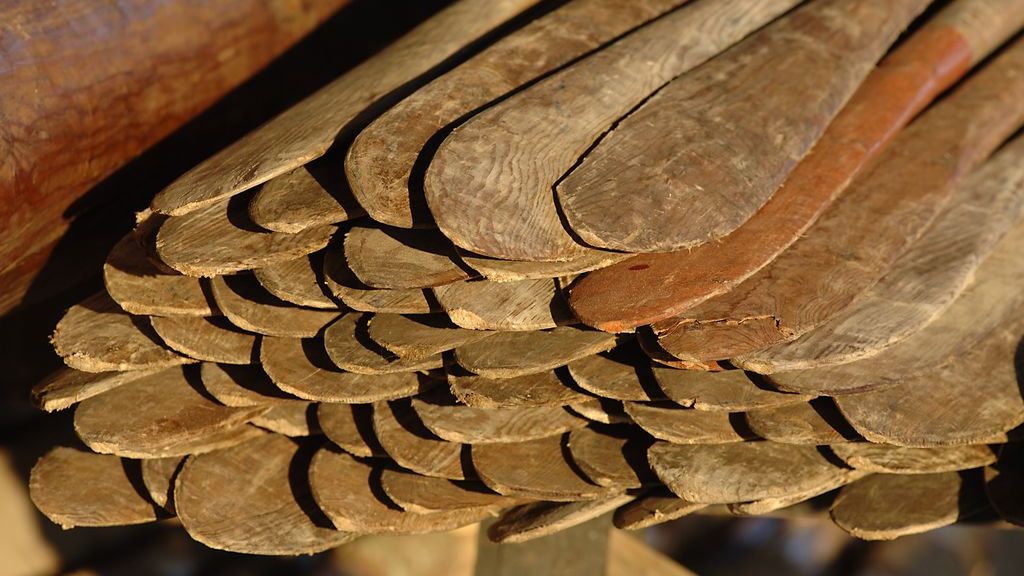However, in 2006, a ship-reconstructor from the Viking Ship Museum noticed something, which gave rise to an extremely rigorous reconstruction process, with the end result that the ship could be resurrected once again. Now, almost 30 years later, the ship has had a problem-free crossing over Skagerrak on its journey from Tønsberg to Roskilde, where it will arrive at the Museum harbour on 12th of July.
The ship Saga Oseberg is a little sensation. Not just because it is a beautiful reconstruction of an old Viking Ship from 820 AD, but mostly because it sails. This ship is the second attempt at building a reconstruction of the Oseberg Ship, which was found in a burial mound at Tønsberg in Norway, in 1904. The first attempt ended in the dramatic loss of the ship, which sank to the bottom of the sea in just 20 seconds on its maiden voyage – luckily, without any loss of life.
There was clearly something wrong with the construction and for many years after the ship sank, the question of whether the excavated ship had ever been a functioning sailing vessel, or if it had been built as a symbol, to provide a means of transport for the deceased on the way to Valhalla, was much discussed. It wasn’t until 2006, that the first hints as to what had gone wrong with the first reconstruction began to appear.
This happened when a team consisting of boatbuilder Geri Rørvik (Stiftelsen Nytt Osebergskip), archaeologist Knut Paasche (Kulturhistorisk Museum I Oslo) and ship-reconstructor Vibeke Bishcoff (Viking Ship Museum in Roskilde) took a closer look at the original find. They established that there was apparently nothing wrong with the old ship, just with the way in which it had previously been observed.
Shortcuts
Vibeke Bischoff from the Viking Ship Museum is an experienced ship-reconstructor, and from the first time she examined the old Oseberg Ship, which stands on display at the Viking Ship Museum at Bygdøy, Oslo, she noticed that there were several serious flaws in the way the ship had been reconstructed and set up for exhibition. Several of the crossbeams had their ends sawn over and shortened, other elements of the ship’s hull had been pressed inwards at an unnatural angle and individual frames were deformed.
The general picture suggested that some shortcuts had been taken, in order to get the pieces to fit together. Since the parts of the ship-find didn’t fit back together properly, there was also the possibility that the Oseberg Ship had in fact been incorrectly fitted together when displayed. This in turn would affect the form of the ship’s hull, resulting in a rounder entry and poorer sailing capability – something, which may have contributed to the loss of the first reconstruction.
Let the find talk
'When we look at an archaeological find, we have to let it talk. It is unbelievably important, to listen to what the fragments are telling us', says ship-reconstructor, Vibeke Bischoff, from the Viking Ship Museum in Roskilde. 'If the crossbeams are too long, then there is obviously a problem with the way in which we have assembled the jigsaw, and not with the pieces of the puzzle. In archaeological reconstruction, no interpretations of the hull’s capabilities should be made in advance. It’s all about being neutral in terms of the material and its form, about being open.'
The team carried out a thorough re-examination of the original ship. Each plank was carefully scanned and measured. Changes in their form due to deformation and dehydration were taken into account, and the new measurements were constantly checked against the existing drawings from the excavation documentation. Afterwards, each plank was recreated in cardboard, at a scale of 1:10, and hull was planked-up, until the model was complete; now with a more concave cross-section in the bow, which lifts the forestem higher over the water. This lift gives the ship a greater rocker than had previously been recognised. All of these factors are of crucial importance for the movement of the water around the hull and would also seem to imply better sailing capabilities.
'Our results are based on many years experience with, and knowledge of, traditional small boats in all of Scandinavia, and of course, the maritime craftwork that they involve', concludes Vibeke Bischoff, 'However, we can’t say that we have the definitive answer in terms of how the Oseberg Ship looked, only that we have a good suggestion. There is still room for specialist discussion about the details, and that’s also how it should be – just so long as we always remember to be open to new ideas.' The ship has since been built in full scale by Stiftelsen Nytt Osebergskip (SNOS) in Tønsberg, and the construction was based on the model and drawings, which were produced by Vibeke Bischoff. The new reconstruction was launched in 2012, and named Saga Oseberg. It is this ship, which is now on its way to Roskilde.
Saga Oseberg will carry out test-sailing in Roskilde from the 12th - 18th July and invites guests to visit the 'open ship'
Right now, the ship and its twenty-strong crew are on the way to the Viking Ship Museum in Roskilde, where they will carry out a series of test-sailings in order to explore the ship’s sailing capabilities from the 12th – 18th July. Vibeke Bischoff is on board as skipper and will take part in the test-sailing, together with the crewmembers from SNOS and a select group of skilled sailors from the Museum. When Saga Oseberg isn’t carrying out tests, the ship will be moored at the Viking Ship Museum’s harbour, where all are welcome to visit and come on board.
Information:
Burial ship from Oseberg
The original Oseberg Ship dates from 820 AD and was found in 1904 in a burial mound at Tønsberg, Norway. Here, the ship served as the final resting place for two high-status women, who lay on a bed in a chamber behind the ship’s mast, and were surrounded by fine objects, wall-hangings and figures. The ship itself is exquisitely made, with beautiful carved ornament along the keel and with stately, spiral-shaped snake-heads on the stems. The ship is built of oak, is 21.5m long and some 5m broad, and has room for 30 oarsmen. The first reconstruction was named ‘Dronningen’ and sank on her maiden voyage in 1987.
Ship-reconstructor Vibeke Bischoff
Vibeke Bischoff has been a ship-reconstructor at the Viking Ship Museum since 2003 and has great experience with interpreting and reconstructing archaeological ship-finds. She has been involved in the construction of several of the Museum’s own boats and has sailed as skipper on several of the ships, such as Sea Stallion from Glendalough, and now also on Saga Oseberg on its journey from Oslo to Roskilde.
![[Translate to english:] Foto: Jørgen Kirsebom
[Translate to english:] Foto: Jørgen Kirsebom](/frontend/_processed_/2/7/csm_Oseberg_03_2c268f5957.jpg)



![[Translate to english:] Osebergskibet, som det er udstillet på Vikingskipshuset, Bygdøy, Oslo, Norge (foto: Vikingskipshuset)
[Translate to english:] Osebergskibet, som det er udstillet på Vikingskipshuset, Bygdøy, Oslo, Norge (foto: Vikingskipshuset)](/frontend/_processed_/3/c/csm_Oseberg_45b38dabe4.jpg)
![[Translate to english:] Den detaljerede model af Osebergskibet plankes op i forholdet 1:10. klik på billedet for at downloade.
[Translate to english:] Den detaljerede model af Osebergskibet plankes op i forholdet 1:10. klik på billedet for at downloade.](/frontend/_processed_/7/9/csm_2006_09_27_14_28_43_WK_71f96df87d.jpg)
![[Translate to english:] Den detaljerede model af Osebergskibet plankes op i forholdet 1:10. klik på billedet for at downloade.
[Translate to english:] Den detaljerede model af Osebergskibet plankes op i forholdet 1:10. klik på billedet for at downloade.](/frontend/_processed_/a/3/csm_2006_09_28_11_48_42_WK_2f00d16bf5.jpg)
![[Translate to english:] Eksempler på steder, hvor samlingerne ikke passer på det originale skib. klik på billedet for at downloade.
[Translate to english:] Eksempler på steder, hvor samlingerne ikke passer på det originale skib. klik på billedet for at downloade.](/frontend/_processed_/f/0/csm_2_6dd5bc_1c29402582.jpg)
![[Translate to english:] Eksempler på steder, hvor samlingerne ikke passer på det originale skib. klik på billedet for at downloade.
[Translate to english:] Eksempler på steder, hvor samlingerne ikke passer på det originale skib. klik på billedet for at downloade.](/frontend/_processed_/e/1/csm_1_94_a1ef594879.jpg)
![[Translate to english:] Saga Oseberg. (foto: SNOS) klik på billedet for at downloade.
[Translate to english:] Saga Oseberg. (foto: SNOS) klik på billedet for at downloade.](/frontend/_processed_/3/c/csm_552px-SagaOseberg_tbg_8ee238412c.jpg)
![[Translate to english:] Saga Oseberg ved Verdens Ende ved åbningen af Færder nasjonalparksenter i juni. (Foto Jørgen Kirsebom) klik på billedet for at downloade.
[Translate to english:] Saga Oseberg ved Verdens Ende ved åbningen af Færder nasjonalparksenter i juni. (Foto Jørgen Kirsebom) klik på billedet for at downloade.](/frontend/_processed_/3/9/csm_saga_oseberg-verdens_ende_02_77c3958e5f.jpg)
![[Translate to english:] Vibeke Bischoff. klik på billedet for at downloade. [Translate to english:] Vibeke Bischoff. klik på billedet for at downloade.](/frontend/_processed_/9/2/csm_2009_06_19_18_03_14-1_WK__f3f20225a1.jpg)